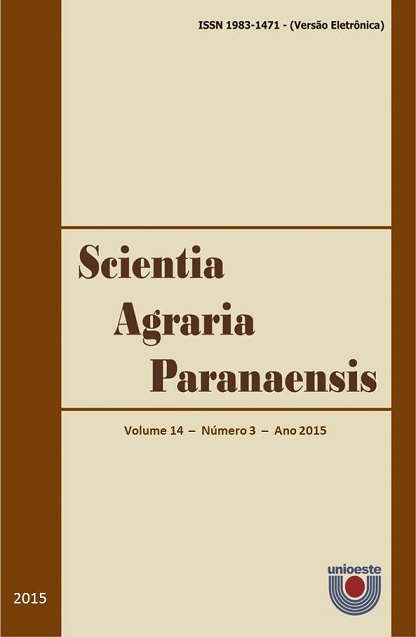Water status maintenance induced by Trinexapac-Ethyl in soybean plants
DOI:
https://doi.org/10.18188/sap.v14i3.9224Keywords:
controle estomático, déficit hídrico, Glycine max L. Merril, inibidores de giberelina, tolerância protoplasmáticaAbstract
Improving abiotic stress tolerance in plants by crop management is one of biggest goals of actual research, thus, plant growth regulators have a great potential in the physiological manure of crops. The objective of this work was to evaluate the effects of Trinexapac-Ethyl on soybean plants affected by drought stress during the reproductive stage. Four Trinexapac-Ethyl doses were evaluated (0, 50, 100, and 200 g ha-1 a.i.) and the induction or not of drought stress. The experimental design was completely randomized blocks in factorial design (4x2) with four replications. Relative water content was measured during drought stress and rehydration period. Protoplasmic tolerance and biometric parameters were determined after recovery period. Yield and yield components were determined at the end of crop cycle. Low intensity drought stress was verified at this work, which affected the plant growth but did not affect soybean yield. Trinexapac-Ethyl application resulted in maintenance of leaves relative water content, mainly at 200 g ha-1 dose, without affect biometric parameters and grain yield. This behavior is a great indicative of increase in soybean drought tolerance.Downloads
Additional Files
Published
18-09-2015
How to Cite
FIOREZE, S. L.; GUIMARÃES, V. F. Water status maintenance induced by Trinexapac-Ethyl in soybean plants. Scientia Agraria Paranaensis, [S. l.], v. 14, n. 3, p. 166–172, 2015. DOI: 10.18188/sap.v14i3.9224. Disponível em: https://e-revista.unioeste.br/index.php/scientiaagraria/article/view/9224. Acesso em: 25 may. 2025.
Issue
Section
Scientific Article
License
Aviso de Direito Autoral Creative Commons
Política para Periódicos de Acesso Livre
Autores que publicam nesta revista concordam com os seguintes termos:
1. Autores mantém os direitos autorais e concedem à revista o direito de primeira publicação, com o trabalho simultaneamente licenciado sob a Licença Creative Commons Attribution que permite o compartilhamento do trabalho com reconhecimento da autoria e publicação inicial nesta revista.2. Autores têm autorização para assumir contratos adicionais separadamente, para distribuição não-exclusiva da versão do trabalho publicada nesta revista (ex.: publicar em repositório institucional ou como capítulo de livro), com reconhecimento de autoria e publicação inicial nesta revista.
3. Autores têm permissão e são estimulados a publicar e distribuir seu trabalho online (ex.: em repositórios institucionais ou na sua página pessoal) a qualquer ponto antes ou durante o processo editorial, já que isso pode gerar alterações produtivas, bem como aumentar o impacto e a citação do trabalho publicado (Veja O Efeito do Acesso Livre).
Licença Creative Commons
Esta obra está licenciada com uma Licença Creative Commons Atribuição-NãoComercial-CompartilhaIgual 4.0 Internacional, o que permite compartilhar, copiar, distribuir, exibir, reproduzir, a totalidade ou partes desde que não tenha objetivo comercial e sejam citados os autores e a fonte.


